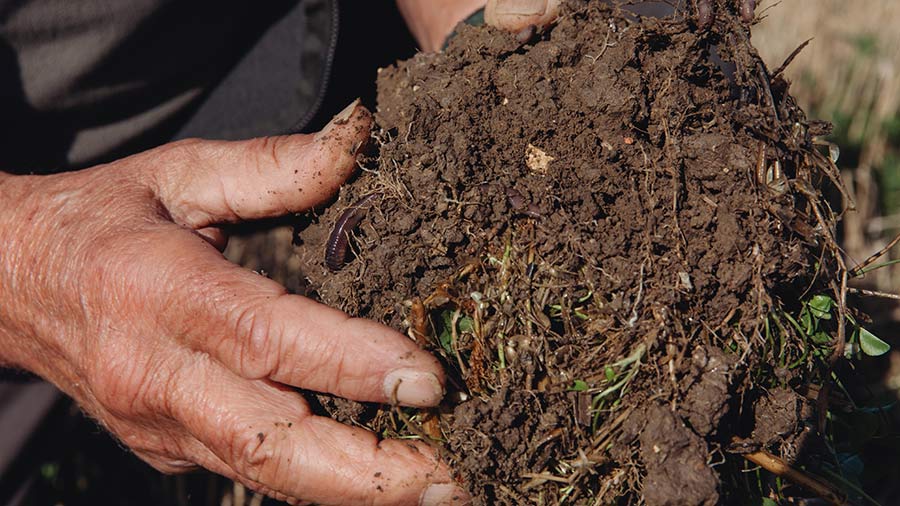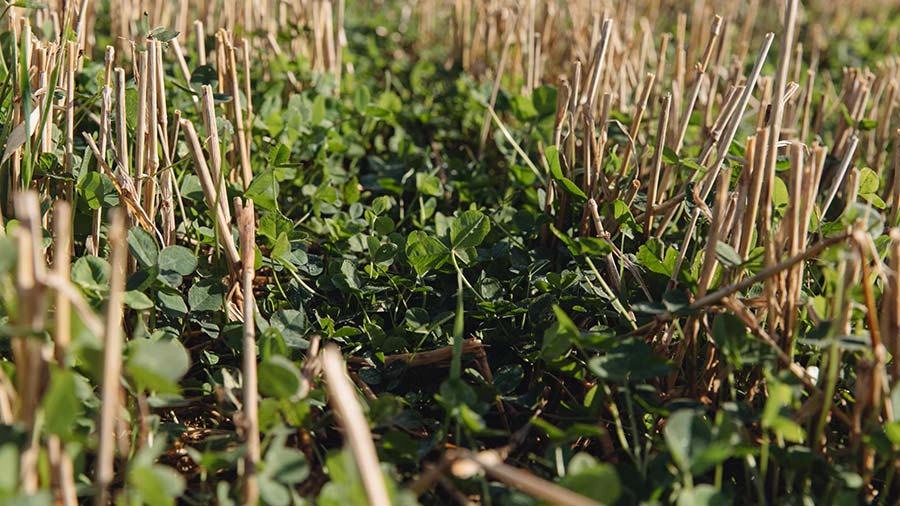How measured soil carbon credits can replace BPS income
 © Blaston Estate
© Blaston Estate The first farm in the UK to sell measured soil carbon from arable land is on track to replace its Basic Payment Scheme (BPS) with carbon sales expected to contribute £200-£300/ha a year at current sequestration rates.
Blaston Estate in Leicestershire has worked with Ecometric, Indigro and Fisher German to measure the actual changes in soil carbon from its cropped land.
This follows an overhaul of the farming system which began in 2010.
See also: Video: Grower completes world’s first Capulet bean harvest
A focus on soil health through diversified cropping and rotational livestock resulted in a total of 5,000t being sequestered at Blaston in 2021-22.
If sold, and with carbon presently trading in the low 30s (£/t), this represents potential income of about £160,000.
Gradual move to diverse rotation
The 400ha farm’s phased move to regenerative techniques has seen a much more diverse rotation replacing the previous wheat/OSR system.
This, along with the integration of low-density livestock, grass and cover crops, has been behind its transformation.
Today, a key component is a permanent understorey of white clover, which is contributing about 40kg/ha of nitrogen to spring cereal crops and replacing the need for bagged fertiliser.
It is also feeding the sheep, improving soil function and building carbon.
Owner Hylton Murray Philipson had previous experience with the carbon markets through forest credits with Respira
He recognised that the farm’s soil carbon could be monetised if he could find a way of both increasing it and keeping it in the ground.
Determined to leave the farm in a better condition than he inherited, and aware of the climate crisis, he embarked on a programme which would see it continue to produce food while having other income streams.
“It’s based on good farming practice, with minimal soil disturbance, maximum diversity and almost-permanent soil cover,” he says.
“We had to manage and measure our efforts before we could monetise them.”

A permanent understorey of white clover is contributing around 40kg/ha of nitrogen to spring cereal crops at Blaston Estate © Blaston Estate
Contract commitment
As part of his contract, he has made a 10-year permanence commitment and must respect a restriction on soil disturbance, which limits soil movement to the top 10cm.
Helped by independent agronomist Roger Davis of Indigro and his 4Rs plan, the 400ha heavy land farm has seen soil organic matter levels rise as changes were implemented.
The 4Rs stand for resilience, reliance, risk and reward,
The resilience provided by better soil health and reduced cultivations has had wider benefits for water management and biodiversity, explains Roger, while the farm’s reliance on artificial inputs and fuel has been reduced.
Risk was managed by making gradual changes and running a system which needs less cash.
The rewards have been seen in various ways – higher yields, lower costs, enhanced natural capital value and payments from agri-environment schemes, water company support and the carbon scheme.
Next steps
Looking ahead, they will continue to improve the regenerative practices, to further raise the farm’s resilience, sustainability and profitability.
They will also share their knowledge, especially when it comes to increasing carbon sequestration rates.
“That could be done by putting black oats or buckwheat into the permanent clover,” suggests Roger.
“Their deeper roots would help with soil structure and nutrient scavenging, building more carbon at depth.”
Leaving grass leys in years three and four to grow very high, before bringing suckler cattle in to graze them down, is another possibility when it comes to building more soil carbon.
“We are learning all the time about clover management.
“The white clover usually starts as a component of a cover crop mix and then remains after the cover has been sprayed off, so we direct drill the spring cereal into it.”
Financial progress
Richard Sanders of Fisher German explains that the farm’s finances were negative in 2018, 2019 and 2020.
This was largely due to wet autumns and winter periods and the need to bring livestock into the changing system.
Support from Severn Trent Water to the tune of £390/ha helped with the transition and funded cover crops, field boundary features and wetlands.
That relationship continues, with £150/ha coming from the water company this year, with the Sustainable Farming Incentive and Countryside Stewardship contributing £80/ha.
By 2021 and 2022, the margins were positive, notes Richard. In 2023, it is more than £250/ha.
“If sequestration rates continue as they are, carbon sales will contribute £200-300/ha/year, making up for the loss of BPS.”
Interestingly, there were a few fields that lost carbon last year, reveals Richard.
“We could investigate why that happened with Ecometric.
“It turns out that the crop didn’t establish well and was then grazed, removing the canopy, so it wasn’t harvesting carbon dioxide and sunlight as planned.”
Rotational changes |
|
| 2010 | 2023 |
| Winter wheat | Winter wheat |
| Winter oilseed rape | Legume and herb-rich leys |
| Permanent Pasture | Spring wheat – grown in white clover following cover crop |
| 75 lambing ewes | Grass leys |
| Countryside Stewardship AB15 | |
| Permanent pasture | |
| Walnuts | |
| Countryside Stewardship pollinator strips | |
| 47 suckler cows | |
| 550 lambing ewes | |
Blaston Estate – margin and cost comparison (£/ha) |
|||
| Gross margin | Contracting/crop costs | Net margin | |
| Cropping | |||
| Winter wheat | 1,112 | 520 | 592 |
| Winter OSR | 810 | 520 | 290 |
| Winter beans | 940 | 470 | 470 |
| Spring oats | 590 | 370 | 220 |
| Spring barley | 617 | 370 | 247 |
| Countryside Stewardship | |||
| GS4 legume/herb sward | 382 | 90 | 292 |
| AB6 enhanced overwintered stubbles | 522 | 60 | 462 |
| AB15 legume fallow | 593 | 190 | 403 |
How does the ecometric system work?
The Ecometric approach is measurement-based rather than model-based, giving farmers a highly accurate carbon balance by recording the outcome and relating it to the cause. This thereby links management practices to the resulting soil carbon response.
This makes it different to the soil carbon systems that operate a modelled approach.
Ecometric uses AI to combine traditional soil sampling and laboratory analysis with remote sensing, explains founder David Wright, who adds that it is affordable and scalable.
Already being used across 38,000ha, he has a target of 100,000ha in the UK this year.
As a measurement-based system, it has been peer reviewed and registry accredited. “It’s been through scientific scrutiny and sets a new integrity standard,” he adds.
“Buyers are increasingly focused on integrity and are moving away from emissions reduction to carbon dioxide removal.”
Aligned with the Regen Network, a platform to originate and invest in high integrity carbon and biodiversity credits, there is a six-step process to go through with each project:
- Register project
- Establish baseline
- Implement project
- Monitor change
- Issue credits
- Sell credits.
“Farmers can choose how to sell the credits. There’s a wide opportunity to reach buyers.”
Assumption-based carbon models are much less accurate, thinks David. “There can be very high levels of error, so they can’t influence change in the same way.”
There’s a cost of £63/ha/year for the Ecometric service.
Carbon credits buyer
John Biggin of TruckEast, the Scania dealer group, has purchased some of the first carbon credits from Blaston Estate.
He has done everything he can to ensure that his business is more sustainable – from installing solar panels, changing the lighting and eliminating plastic where possible.
However, it still produces 1,000t of carbon and has to report that total in the company accounts.
“I’m sure we’ll get taxed on it one day,” he says. “In the meantime, we are doing what we can, including planting a tree for every truck that we sell.
“Buying carbon credits is another way of showing our commitment.”

